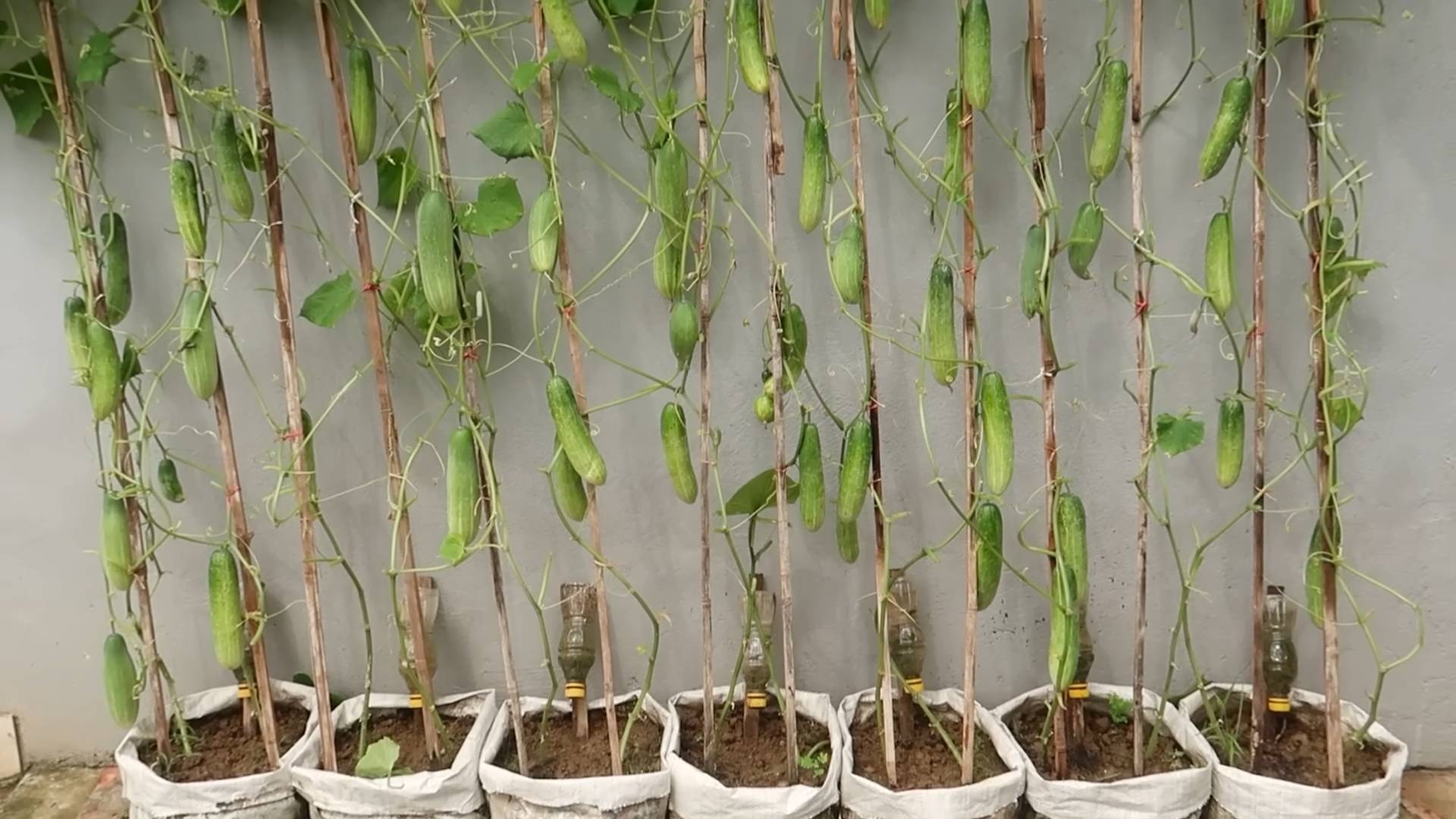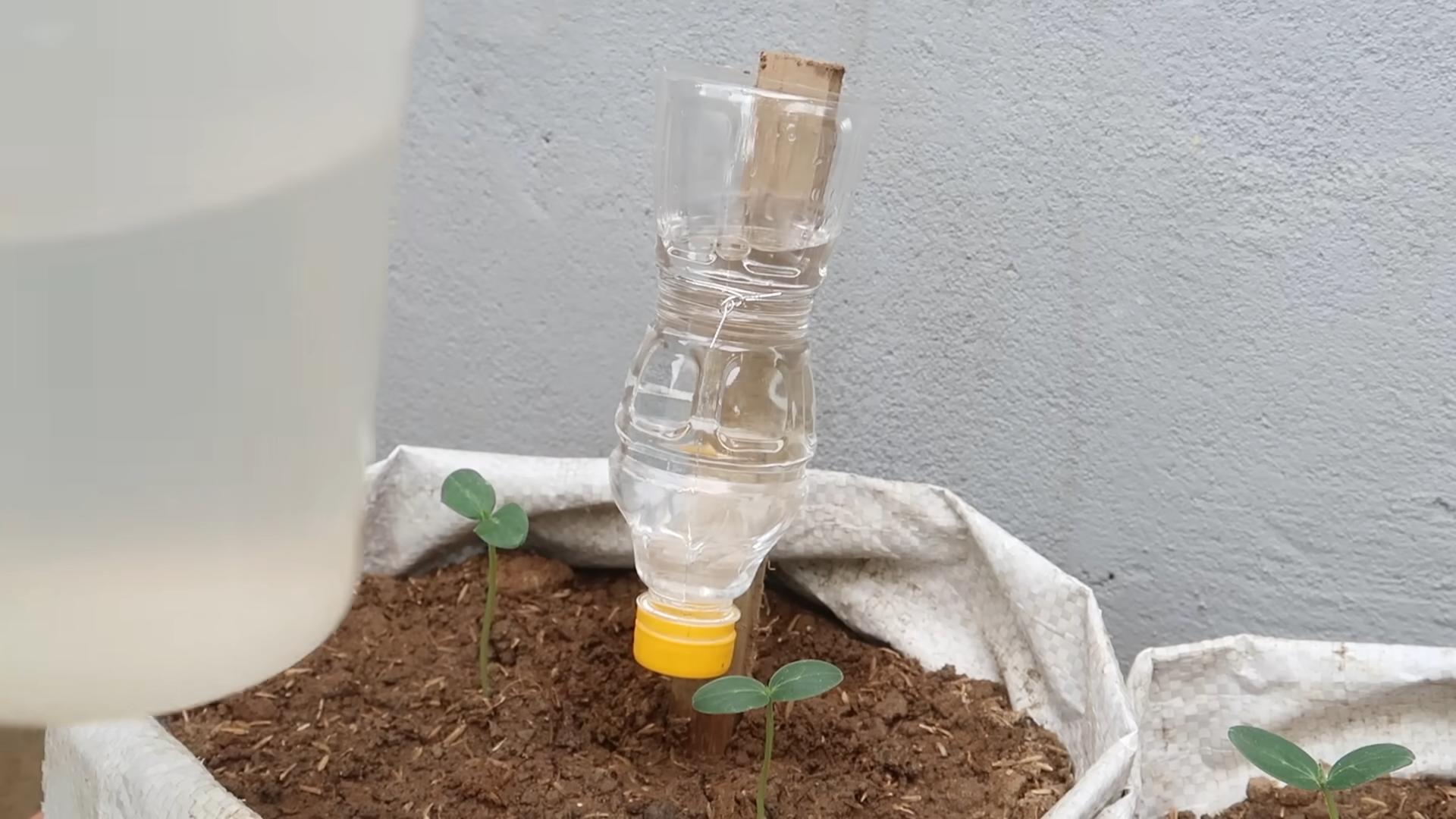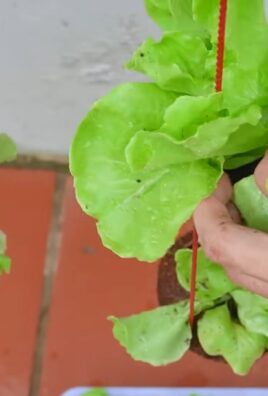Growing Cucumbers at Home can seem daunting, especially if you’re new to gardening. But trust me, with a few clever tricks and a little DIY spirit, you can be harvesting crisp, refreshing cucumbers from your own backyard in no time! Imagine biting into a juicy cucumber you nurtured from seed – the taste is simply unmatched.
Cucumbers have a rich history, dating back thousands of years to their origins in India. They’ve been cultivated and enjoyed across cultures, from ancient Rome to the gardens of colonial America. For centuries, people have relied on simple techniques to maximize their cucumber yields, and I’m excited to share some of those time-tested secrets with you.
Why bother with the effort of growing your own cucumbers? Well, for starters, homegrown cucumbers taste infinitely better than anything you’ll find at the grocery store. Plus, you have complete control over what goes into your garden, ensuring you’re enjoying healthy, pesticide-free produce. But beyond the taste and health benefits, growing cucumbers at home is incredibly rewarding. It’s a chance to connect with nature, learn new skills, and enjoy the satisfaction of nurturing something from seed to harvest. In this article, I’ll guide you through some easy DIY tricks and hacks that will help you achieve a bountiful cucumber harvest, even if you have limited space or experience. Let’s get started!

Growing Cucumbers at Home: A Beginner’s Guide to Crunchy Success
Hey there, fellow gardening enthusiasts! I’m so excited to share my experiences and tips for growing cucumbers right in your own backyard (or even on your balcony!). There’s nothing quite like the taste of a freshly picked, crisp cucumber, and trust me, it’s easier than you think to achieve that deliciousness yourself. Let’s dive in!
Choosing Your Cucumber Variety
Before we get our hands dirty, let’s talk cucumbers. There are tons of different varieties, and picking the right one for your space and needs is crucial. Here’s a quick rundown:
* Slicing Cucumbers: These are your classic, long, smooth-skinned cucumbers perfect for salads and sandwiches. Think ‘Marketmore’ or ‘Straight Eight’.
* Pickling Cucumbers: Shorter and stubbier with bumpy skin, these are ideal for, you guessed it, pickling! ‘National Pickling’ and ‘Boston Pickling’ are popular choices.
* Burpless Cucumbers: These are bred to be less bitter and easier to digest. ‘Sweet Slice’ and ‘Armenian’ (which is technically a melon, but grown like a cucumber) are great options.
* Bush Cucumbers: If you’re short on space, bush varieties like ‘Spacemaster’ are your best bet. They’re compact and perfect for containers.
Consider your climate, available space, and how you plan to use your cucumbers when making your selection. I personally love growing ‘Marketmore’ for salads and ‘National Pickling’ for, well, pickles!
Getting Started: Planting Your Cucumbers
Now for the fun part! You have two main options for starting your cucumber plants: starting from seed indoors or directly sowing seeds outdoors.
Starting Seeds Indoors (Recommended for Cooler Climates)
Starting seeds indoors gives you a head start, especially if you live in a region with a shorter growing season. I usually start my seeds about 3-4 weeks before the last expected frost.
1. Gather Your Supplies: You’ll need seed starting trays or small pots, seed starting mix (not regular potting soil!), cucumber seeds, and a spray bottle.
2. Sow the Seeds: Fill your trays or pots with seed starting mix. Make a small indentation (about ½ inch deep) in the center of each cell or pot. Place 2-3 cucumber seeds in each indentation. This increases the chances of at least one seed germinating.
3. Cover and Water: Gently cover the seeds with more seed starting mix. Lightly mist the soil with water using your spray bottle. You want the soil to be moist, but not soggy.
4. Provide Warmth and Light: Cucumber seeds need warmth to germinate. Place your trays or pots in a warm location, like on top of your refrigerator or on a heat mat. Once the seedlings emerge (usually within 5-10 days), move them to a sunny windowsill or under grow lights. They need at least 6 hours of light per day.
5. Keep the Soil Moist: Water regularly to keep the soil consistently moist. Avoid overwatering, which can lead to damping off (a fungal disease that kills seedlings).
6. Harden Off the Seedlings: About a week before you plan to transplant your seedlings outdoors, you need to “harden them off.” This means gradually exposing them to outdoor conditions. Start by placing them outside for an hour or two each day, gradually increasing the amount of time they spend outdoors. This will help them adjust to the sun, wind, and temperature changes.
Direct Sowing Seeds Outdoors (For Warmer Climates)
If you live in a warmer climate with a longer growing season, you can directly sow cucumber seeds outdoors after the danger of frost has passed and the soil has warmed up to at least 60°F (15°C).
1. Prepare the Soil: Choose a sunny location with well-drained soil. Cucumbers need at least 6-8 hours of sunlight per day. Amend the soil with compost or well-rotted manure to improve its fertility and drainage.
2. Sow the Seeds: Sow the seeds about 1 inch deep and 2-3 inches apart. If you’re planting in rows, space the rows about 3-4 feet apart.
3. Water Gently: Water the soil gently after planting. Keep the soil consistently moist until the seeds germinate.
4. Thin the Seedlings: Once the seedlings emerge, thin them to about 12-18 inches apart. This will give them enough space to grow and thrive.
Transplanting Your Cucumber Seedlings
Whether you started your seeds indoors or bought seedlings from a nursery, transplanting them into your garden is a crucial step.
1. Choose a Sunny Location: As I mentioned before, cucumbers need at least 6-8 hours of sunlight per day.
2. Prepare the Soil: Make sure the soil is well-drained and amended with compost or well-rotted manure.
3. Dig the Holes: Dig holes that are slightly larger than the root balls of your seedlings. Space the holes about 12-18 inches apart.
4. Gently Remove the Seedlings: Carefully remove the seedlings from their trays or pots. Be gentle to avoid damaging the roots.
5. Place the Seedlings in the Holes: Place the seedlings in the holes and gently backfill with soil. Make sure the top of the root ball is level with the surrounding soil.
6. Water Thoroughly: Water the seedlings thoroughly after transplanting.
7. Mulch Around the Plants: Apply a layer of mulch around the plants to help retain moisture, suppress weeds, and regulate soil temperature. I like to use straw or wood chips.
Providing Support: Trellising Your Cucumbers
Cucumbers are vining plants, which means they need support to grow properly. Trellising your cucumbers has several benefits:
* Saves Space: Trellising allows you to grow more cucumbers in a smaller space.
* Improves Air Circulation: Good air circulation helps prevent fungal diseases.
* Easier Harvesting: Trellised cucumbers are easier to harvest because they’re off the ground.
* Cleaner Fruit: Trellising keeps the cucumbers off the ground, preventing them from getting dirty or rotting.
There are several different types of trellises you can use:
* A-Frame Trellis: This is a simple and sturdy trellis that’s easy to build.
* Vertical Trellis: This is a good option for smaller gardens. You can use a fence, wall, or even a sturdy stake as a trellis.
* Cattle Panel Trellis: This is a strong and durable trellis that can support a lot of weight.
No matter which type of trellis you choose, make sure it’s tall enough to support the full growth of your cucumber plants. I usually aim for a trellis that’s at least 6 feet tall.
1. Install the Trellis: Install the trellis before or shortly after transplanting your cucumber seedlings.
2. Train the Vines: As the cucumber vines grow, gently guide them onto the trellis. You may need to tie them to the trellis with twine or plant clips.
Caring for Your Cucumber Plants
Once your cucumber plants are established, it’s important to provide them with proper care to ensure a bountiful harvest.
* Watering: Cucumbers need consistent moisture, especially during hot weather. Water deeply and regularly, aiming for about 1 inch of water per week. Avoid overhead watering, which can lead to fungal diseases. Drip irrigation or soaker hoses are ideal.
* Fertilizing: Feed your cucumber plants with a balanced fertilizer every 2-3 weeks. Look for a fertilizer that’s high in phosphorus and potassium, which are essential for fruit production. I like to use a liquid fertilizer diluted to half strength.
* Weeding: Keep the area around your cucumber plants free of weeds. Weeds compete with your plants for water and nutrients.
* Pest Control: Keep an eye out for common cucumber pests, such as aphids, cucumber beetles, and squash bugs. You can control these pests with insecticidal soap, neem oil, or by handpicking them off the plants.
* Disease Control: Cucumbers are susceptible to several fungal diseases, such as powdery mildew and downy mildew. To prevent these diseases, provide good air circulation, avoid overhead watering, and apply a fungicide if necessary.
Harvesting Your Cucumbers
The moment we’ve all been waiting for! Harvesting your cucumbers at the right time is crucial for getting the best flavor and texture.
* Harvest Time: The time it takes for cucumbers to mature depends on the variety. Generally, you can start harvesting cucumbers about 50-70 days after planting.
* Harvesting Tips: Harvest cucumbers when they’re the desired size and color. Slicing cucumbers are usually harvested when they’re about 6

Conclusion
So, there you have it! Growing cucumbers at home is not only achievable, but it’s also incredibly rewarding. Forget those bland, waxed cucumbers from the grocery store. Imagine biting into a crisp, juicy cucumber, bursting with flavor, that you nurtured from seed to harvest. That’s the magic of homegrown!
This DIY approach to cucumber cultivation empowers you to control the entire process, from soil composition to pest management, ensuring you get the healthiest and most delicious cucumbers possible. Plus, it’s a fantastic way to connect with nature and learn about the life cycle of plants.
But why is this DIY trick a must-try? Because it’s about more than just saving money (although that’s a definite perk!). It’s about experiencing the satisfaction of growing your own food, reducing your carbon footprint by minimizing transportation, and enjoying a superior product that simply can’t be matched by commercially grown alternatives. The taste difference alone is enough to convert anyone!
Ready to take your cucumber game to the next level? Consider experimenting with different cucumber varieties. Bush cucumbers are ideal for container gardening and smaller spaces, while vining cucumbers thrive when given a trellis to climb. You can also try pickling varieties for making your own homemade pickles, or slicing varieties for fresh salads and snacks.
Another fun variation is to explore companion planting. Marigolds, for example, are known to deter pests, while dill attracts beneficial insects. Planting these alongside your cucumbers can create a healthier and more productive garden. You can also try growing cucumbers in raised beds for improved drainage and soil control.
Don’t be afraid to get your hands dirty and experiment! Gardening is a journey of learning and discovery. Every season brings new challenges and opportunities. The key is to be patient, observant, and willing to adapt your approach as needed.
We are confident that with a little effort and the tips outlined in this guide, you’ll be enjoying a bountiful harvest of delicious, homegrown cucumbers in no time.
Now, we want to hear from you! Have you tried growing cucumbers at home before? What challenges did you face? What successes did you celebrate? Share your experiences, tips, and tricks in the comments below. Let’s create a community of cucumber enthusiasts and learn from each other. We encourage you to try this DIY trick for growing cucumbers and share your results with us! Happy gardening!
Frequently Asked Questions (FAQ)
Q: What is the best time to start growing cucumbers?
A: The best time to start growing cucumbers depends on your climate. Cucumbers are warm-season vegetables and are sensitive to frost. In general, you can start seeds indoors about 3-4 weeks before the last expected frost. If you’re planting directly in the ground, wait until the soil has warmed up to at least 60°F (15°C). This is typically a few weeks after the last frost. In warmer climates, you can plant cucumbers multiple times throughout the growing season for a continuous harvest. Check your local planting calendar for specific dates.
Q: What kind of soil is best for growing cucumbers?
A: Cucumbers thrive in well-drained, fertile soil that is rich in organic matter. The ideal soil pH is between 6.0 and 7.0. Before planting, amend your soil with compost or well-rotted manure to improve its fertility and drainage. If your soil is heavy clay, consider adding sand or perlite to improve drainage. Raised beds are also an excellent option for growing cucumbers, as they provide excellent drainage and allow you to control the soil composition.
Q: How much sunlight do cucumbers need?
A: Cucumbers need at least 6-8 hours of direct sunlight per day to thrive. Choose a location in your garden that receives full sun. If you live in a particularly hot climate, some afternoon shade may be beneficial to prevent the plants from overheating. Insufficient sunlight can lead to weak, leggy plants and reduced fruit production.
Q: How often should I water my cucumber plants?
A: Cucumbers need consistent moisture to produce healthy fruits. Water deeply and regularly, especially during hot, dry weather. Aim to keep the soil consistently moist, but not waterlogged. A good rule of thumb is to water when the top inch of soil feels dry to the touch. Mulching around the plants can help retain moisture and suppress weeds. Drip irrigation or soaker hoses are excellent options for delivering water directly to the roots of the plants.
Q: What are some common pests and diseases that affect cucumbers?
A: Cucumbers are susceptible to several pests and diseases, including cucumber beetles, squash bugs, aphids, powdery mildew, and downy mildew. Regularly inspect your plants for signs of pests or diseases. Use organic pest control methods, such as insecticidal soap or neem oil, to control pests. To prevent diseases, ensure good air circulation around the plants and avoid overhead watering. Remove any infected leaves or plants promptly to prevent the spread of disease. Crop rotation can also help reduce the risk of soilborne diseases.
Q: How do I know when my cucumbers are ready to harvest?
A: Cucumbers are typically ready to harvest 50-70 days after planting, depending on the variety. The size and color of the cucumber will vary depending on the variety, so it’s important to check the seed packet or plant tag for specific information. In general, cucumbers are ready to harvest when they are firm, green, and have reached the desired size. Overripe cucumbers will turn yellow and become bitter. Harvest cucumbers regularly to encourage continued fruit production. Use a sharp knife or pruners to cut the cucumber from the vine, leaving a short stem attached.
Q: Can I grow cucumbers in containers?
A: Yes, you can definitely grow cucumbers in containers! Choose a large container that is at least 12 inches in diameter and depth. Bush cucumber varieties are particularly well-suited for container gardening. Use a high-quality potting mix and provide a trellis or support for the vines to climb. Water regularly and fertilize every 2-3 weeks with a balanced fertilizer. Place the container in a sunny location that receives at least 6-8 hours of direct sunlight per day.
Q: What are some good companion plants for cucumbers?
A: Companion planting can be beneficial for cucumbers by attracting beneficial insects, deterring pests, and improving soil health. Some good companion plants for cucumbers include:
* Marigolds: Deter pests like nematodes and whiteflies.
* Dill: Attracts beneficial insects like ladybugs and hoverflies.
* Nasturtiums: Repel aphids and other pests.
* Beans: Fix nitrogen in the soil, which benefits cucumbers.
* Radishes: Deter cucumber beetles.
* Garlic: Repels various pests.
Avoid planting cucumbers near aromatic herbs like sage, as they can inhibit growth.
Q: How can I prevent my cucumbers from becoming bitter?
A: Bitterness in cucumbers is often caused by stress, such as inconsistent watering, high temperatures, or poor soil conditions. To prevent bitterness:
* Water deeply and regularly, especially during hot, dry weather.
* Provide shade during the hottest part of the day.
* Ensure the soil is well-drained and rich in organic matter.
* Harvest cucumbers regularly, as overripe cucumbers are more likely to be bitter.
* Choose cucumber varieties that are less prone to bitterness.
Q: Can I save seeds from my homegrown cucumbers?
A: Saving seeds from homegrown cucumbers can be tricky, as cucumbers are often cross-pollinated. If you want to save seeds, you’ll need to isolate your cucumber plants to prevent cross-pollination. This can be done by covering the plants with netting or growing them in a greenhouse. Allow the cucumbers to ripen fully on the vine before harvesting the seeds. Ferment the seeds in water for a few days to remove the pulp, then dry them thoroughly before storing them in a cool, dry place. Keep in mind that seeds from hybrid varieties may not produce true-to-type plants.





Leave a Comment